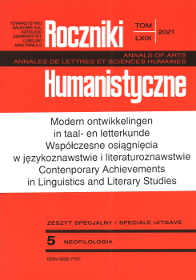Te weinig aandacht voor cultuur in Nederlandse en Vlaamse tekstboeken Nederlands voor anderstaligen?
Abstrakt
Zbyt mało uwagi dla kultury w holenderskich i flamandzkich podręcznikach do nauki języka niderlandzkiego jako obcego?
Powszechnie uznaje się, że kultura i kompetencje międzykulturowe powinny być nieodłączną częścią procesu nauczania języków obcych. Nie ma jednak zgody co do formy i zakresu, w jakim należy je włączać nie tylko do programów nauczania, lecz także do podręczników. Wykorzystując „diagram cebuli” Hofstedego, auyorzy niniejszego artykułu analizują temat „jedzenia i picia” w czterech podręcznikach do nauki języka niderlandzkiego, próbując określić ich treści (inter)kulturowe. Wyniki pokazują, że w analizowanych publikacjach kładzie się nacisk głównie na symbole, tj. zewnętrzną warstwę diagramu. Autorzy przedstawiają wyjaśnienia, krytyczne uwagi i implikacje pedagogiczne oraz postulują porównawcze podejście w nauczaniu kultury i kompetencji interkulturowej.
Bibliografia
Boeken, Christine, Els Le Page, Els Mertens en Ingrid Peeters. Zo gezegd 1.1. Pelckmans, 2015.
Byram, Michael. Teaching and assessing intercultural communicative competence. Multilingual Matters, 1997.
Byram, Michael, Bella Gribkova en Hugh Starkey. Developing the intercultural dimension in language teaching. Council of Europe, 2001.
Claes, Marie-Thérèse en Marinel Gerritsen. Culturele waarden en communicatie ininternationaal perspectief. Coutinho, 2007.
De Leeuw, Elisabeth, Petra Roël en Annemarie Cornax. Contact! 1 Nederlands voor anderstaligen. Intertaal, 2011.
ERK. Gemeenschappelijk Europees referentiekader voor moderne vreemde talen: leren, onderwijzen, beoordelen. Nederlandse Taalunie, 2008.
Hall, Edward. Beyond culture. Anchor Book, 1976.
Hall, Edward. The hidden dimension. Doubleday, 1982.
Hofstede, Geert. Allemaal andersdenkenden. Omgaan met cultuurverschillen. Contact, 1991.
Jewdokimow, Dorota. “Minione w obecnym. O badaniu kultury jako badaniu historycznym w ujęciu semiotycznym.” Studia Kulturoznawcze, vol. 1, nr. 11, 2017, pp. 43-53.
Katan, David. Translating cultures: an introduction for translators, interpreters and mediators. Routledge, 2014.
Kramsch, Claire. Context and culture in language teaching. Oxford University Press, 1993.
Kwakernaak, Erik. “Cultuur in het vreemdetalenonderwijs: franje of kern? Deel 1: terugblik op vijf eeuwen.” Levende Talen Magazine, vol. 104, nr. 7, 2017, pp. 10-14.
Maijala, Minna. “Culture teaching methods in foreign language education: pre-service teachers’ reported beliefs and practices.” Innovation in Language Learning and Teaching, vol. 14, nr. 2, 2018, pp. 133-149.
Meyer, Meinert. “Developing transcultural competence: case studies of advanced foreign language learners.” Mediating languages and cultures, onder redactie van Dieter Buttjes en Michael Byram, Multilinguals Matters, 1990, pp. 136-158.
Piątkowska, Katarzyna. “From cultural knowledge to intercultural communicative competence: changing perspectives on the role of culture in foreign language teaching.” Intercultural Education, vol. 26, nr. 5, 2015, pp. 397-408.
Quist, Gerdi. “Taal, cultuur en interculturele communicatie: tekst als cultuurtekst in de Nvt-klas.” Neerlandistiek in Contrast. Bijdragen aan het Zestiende Colloquium Neerlandicum, onder redactie van Jane Fenoulhet, Arie J. Gelderblom, Marja Kristel, Josien Lalleman, Lut Missine en Jan Pekelder, Rozenberg Publishers, 2007, pp. 395-408.
Schneider-Broekmans, Josina. Taal vitaal – nieuw. Intertaal, 2014.
Schoenaerts, Peter, Rita Devos, Hans Fraeters en Helga van Loo. Vanzelfsprekend. Acco, 2018.
Sercu, Lies. “Teaching foreign languages in an intercultural world.” Foreign language teachers and intercultural competence. An international investigation, onder redactie van Lies Sercu, Ewa Bandura, Paloma Castro, Leah Davcheva, Chryssa Laskaridou, Ulla Lundgren, Maria del Carmen Mendez García en Phyllis Ryan, Multilingual Matters, 2005, pp. 1-18.
Copyright (c) 2021 Roczniki Humanistyczne

Utwór dostępny jest na licencji Creative Commons Uznanie autorstwa – Użycie niekomercyjne – Bez utworów zależnych 4.0 Międzynarodowe.





